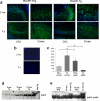C-terminal cleavage of the amyloid-beta protein precursor at Asp664: a switch associated with Alzheimer's disease
- PMID: 18334752
- PMCID: PMC2818039
- DOI: 10.3233/jad-2008-13101
C-terminal cleavage of the amyloid-beta protein precursor at Asp664: a switch associated with Alzheimer's disease
Abstract
In addition to the proteolytic cleavages that give rise to amyloid-beta (Abeta), the amyloid-beta protein precursor (AbetaPP) is cleaved at Asp664 intracytoplasmically. This cleavage releases a cytotoxic peptide, APP-C31, removes AbetaPP-interaction motifs required for signaling and internalization, and is required for the generation of AD-like deficits in a mouse model of the disease. Although we and others had previously shown that Asp664 cleavage of AbetaPP is increased in AD brains, the distribution of the Asp664-cleaved forms of AbetaPP in non-diseased and AD brains at different ages had not been determined. Confirming previous reports, we found that Asp664-cleaved forms of AbetaPP were increased in neuronal cytoplasm and nuclei in early-stage AD brains but were absent in age-matched, non-diseased control brains and in late-stage AD brains. Remarkably, however, Asp664-cleaved AbetaPP was prominent in neuronal somata and in processes in entorhinal cortex and hippocampus of non-diseased human brains at ages <45 years. Our observations suggest that Asp664 cleavage of AbetaPP may be part of the normal proteolytic processing of AbetaPP in young (<45 years) human brain and that this cleavage is down-regulated with normal aging, but is aberrantly increased and altered in location in early AD.
Figures







Similar articles
-
Signal transduction in Alzheimer disease: p21-activated kinase signaling requires C-terminal cleavage of APP at Asp664.J Neurochem. 2008 Feb;104(4):1065-80. doi: 10.1111/j.1471-4159.2007.05031.x. Epub 2007 Nov 6. J Neurochem. 2008. PMID: 17986220 Free PMC article.
-
Long-term prevention of Alzheimer's disease-like behavioral deficits in PDAPP mice carrying a mutation in Asp664.Behav Brain Res. 2008 Aug 22;191(2):246-55. doi: 10.1016/j.bbr.2008.03.035. Epub 2008 Apr 8. Behav Brain Res. 2008. PMID: 18485495 Free PMC article.
-
Production of Amyloid-β in the Aβ-Protein-Precursor Proteolytic Pathway Is Discontinued or Severely Suppressed in Alzheimer's Disease-Affected Neurons: Contesting the 'Obvious'.Genes (Basel). 2025 Jan 2;16(1):46. doi: 10.3390/genes16010046. Genes (Basel). 2025. PMID: 39858593 Free PMC article.
-
Amyloid-β protein precursor family members: a review from homology to biological function.J Alzheimers Dis. 2011;26(4):607-26. doi: 10.3233/JAD-2011-110335. J Alzheimers Dis. 2011. PMID: 21694452 Review.
-
ACH2.0/E, the Consolidated Theory of Conventional and Unconventional Alzheimer's Disease: Origins, Progression, and Therapeutic Strategies.Int J Mol Sci. 2024 May 30;25(11):6036. doi: 10.3390/ijms25116036. Int J Mol Sci. 2024. PMID: 38892224 Free PMC article. Review.
Cited by
-
Importance of the caspase cleavage site in amyloid-β protein precursor.J Alzheimers Dis. 2010;22(1):57-63. doi: 10.3233/JAD-2010-100537. J Alzheimers Dis. 2010. PMID: 20847422 Free PMC article. Review.
-
Cleavage at the 586 amino acid caspase-6 site in mutant huntingtin influences caspase-6 activation in vivo.J Neurosci. 2010 Nov 10;30(45):15019-29. doi: 10.1523/JNEUROSCI.2071-10.2010. J Neurosci. 2010. PMID: 21068307 Free PMC article.
-
Neurodegeneration in Alzheimer's disease: caspases and synaptic element interdependence.Mol Neurodegener. 2009 Jun 26;4:27. doi: 10.1186/1750-1326-4-27. Mol Neurodegener. 2009. PMID: 19558683 Free PMC article.
-
Role of apoptosis in disease.Aging (Albany NY). 2012 May;4(5):330-49. doi: 10.18632/aging.100459. Aging (Albany NY). 2012. PMID: 22683550 Free PMC article. Review.
-
Cytoplasmic SET induces tau hyperphosphorylation through a decrease of methylated phosphatase 2A.BMC Neurosci. 2014 Jun 30;15:82. doi: 10.1186/1471-2202-15-82. BMC Neurosci. 2014. PMID: 24981783 Free PMC article.
References
-
- Artavanis-Tsakonas S, Matsuno K, Fortini ME. Notch signaling. Science. 1995;268:225–232. - PubMed
-
- Baek SH, Ohgi KA, Rose DW, Koo EH, Glass CK, Rosenfeld MG. Exchange of N-CoR corepressor and Tip60 coactivator complexes links gene expression by NF-kappaB and beta-amyloid precursor protein. Cell. 2002;110:55–67. - PubMed
-
- Besnault-Mascard L, Leprince C, Auffredou MT, Meunier B, Bourgeade MF, Camonis J, Lorenzo HK, Vazquez A. Caspase-8 sumoylation is associated with nuclear localization. Oncogene. 2005;24:3268–3273. - PubMed
Publication types
MeSH terms
Substances
Grants and funding
LinkOut - more resources
Full Text Sources
Other Literature Sources
Medical

